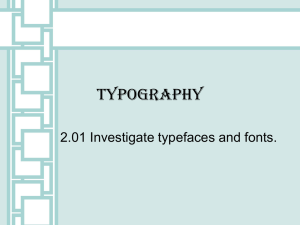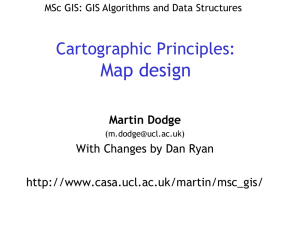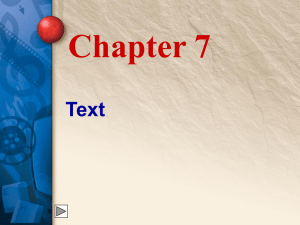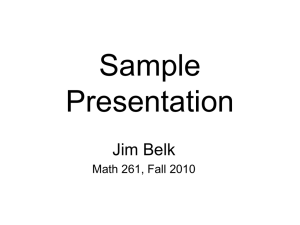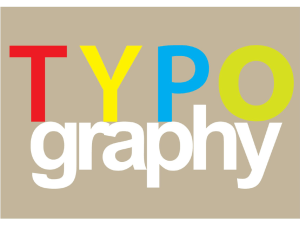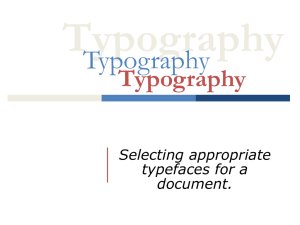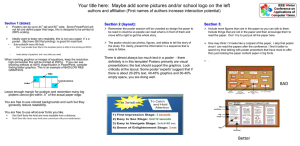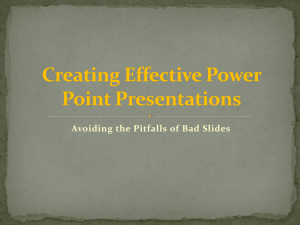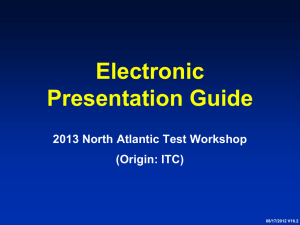Typeface Classification
advertisement
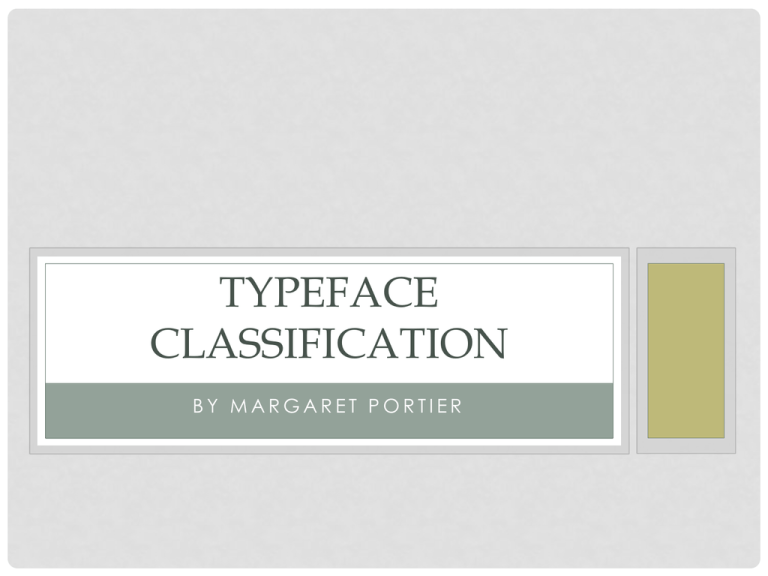
TYPEFACE CLASSIFICATION BY MARGARET PORTIER WHAT IS TYPEFACE? • A typeface is a set of fonts with similar characteristics. • A font is specifically a member of a typeface, such as roman, italic, or boldface • Typeface specifies the consistent visual appearance of a family of fonts • Knowledge of typeface classification is important when choosing fonts for specific purposes or “feelings” • Would you choose Braggadocio for visually impaired readers? Or do you think Comic Sans is a good font for a professional document? ASSOCIATION TYPOGRAPHIQUE INTERNATIONALE (ATypI) • ATypI is an international nonprofit organization dedicated to typography. • In 1962 they adopted the Vox-ATypI classification as a standard. • Originally a nine-part scheme designed by Maximilien Vox in 1954, it is now an 11 part scheme used for classifying typefaces. • It was designed to make sense of the fluidity of typeface design and to illustrate the similarities and differences between types. Vox’s Original nine-part scheme with examples of each part. BASICS OF VOX-ATypI Domain • All known typefaces and fonts Entities • Individual typefaces and fonts CLASSES OF FONTS ACCORDING TO VOX-ATypI CLASSIFICATION • There are three main categories of typeface in the Vox-ATypI Classification scheme: Classical • Classical • Modern • Calligraphic Humanist • Each of these categories can be broken down further into subcategories. Modern Calligraphic Didone Script Mechanistic Graphic Lineal Blackletter Glyphic Gaelic Garald • One other category that is included is Non-Latin which includes fonts and typefaces that are not based on the Latin alphabet (ex. Chinese, Japanese, Hebrew, Arabic, etc.) Transitional VOX-ATypI STRUCTURE • It is a faceted classification that looks at letterforms, influences, and time periods to determine class. • Classical typefaces are often referred to as “old style” and are historically based, they are characterized by triangular serifs and oblique axes. • Modern typefaces are characterized by the simple and functional feel of typefaces generated during the industrial revolution. • Calligraphic typefaces have characteristics that resemble hand writing or are characterized by graphic or imaginative letterforms. A CLOSER LOOK AT CLASS RELATIONSHIPS Typeface Classical Modern Humanist Transitional Garald Didone Mechanistic In the Vox-ATypI classification system, all entities of the same class share similar features. But that does not necessarily mean that they share all of them or that the features shared are exclusive to one class. • • For example, all classical fonts have historical influences but the influences are from different time periods Another example, classical fonts often incorporate serifs, but so do some modern and calligraphic typefaces Calligraphic Lineal Glyphic Grotesque Script Neogrotesque Graphic Geometric Blackletter Humanistic Gaelic Non-latin CROSS-CATEGORY CLASSIFICATIONS • “Humanist” is a term that is used multiple times in different categories. • In Classical fonts, humanist fonts resemble the text found in renaissance writings. (ex. Perpetua) • In Modern Lineal fonts, the humanist subcategory contains sans-serif fonts that resemble monumental Roman capitals (ex. Gill Sans) • “Blackletter” is another term that can be used multiple times. • It is a subcategory of the Modern Lineal class • It is a synonym for “bold” • Because a font is a specific instance of a typeface, there is a difference between the following styles: • • • • • Roman Italic Blackletter (or bold) Condensed Light THE PROBLEM WITH LETTERFORMS • Letterforms are the shapes that characterize specific fonts • (for a detailed list, look at this website: http://www.bsu.edu/web/ucspubs/pdf/other/letterform_anato my.pdf) • Serifs are visible in all three main categories of typeface, but if you look more specifically at the Modern typefaces, the Lineal subcategory is sans-serif. • In fact, ALL sans-serif fonts are classified as Lineal Modern. • One problem with using letterforms to classify typefaces is the presence of font families that have both serif and sans-serif forms • For example: Lucida Bright and Lucida Sans are in the same font family, but Lucida Bright would be classified as Mechanistic Modern and Lucida Sans as Lineal Modern. IMPRESSION • Overall, I think this classification scheme is best suited to historical and academic studies of typeface design. The major categories are broad and all-encompassing, but the lines that separate the subcategories are somewhat vague in places and one typeface can have the characteristics of more than one style. • The recurrence of common terms, such as humanist and blackletter, can make it difficult to understand the relative location of one typeface in the overall classification scheme. • Also, there is only one subcategory for describing “graphic” typefaces. In this current age, the number of fonts that fit in the Graphic category is skyrocketing and the Vox-ATypI classification scheme is ill-equipped to adapt. BIBLIOGRAPHY • Typography. (n.d.). In Fine arts @ fontbonne. Retrieved March 5, 2011, from http://finearts.fontbonne.edu/tech/type/index.html • Haralambous, Y. (2007). Fonts and encoding: From unicode to advanced typography and everything in between. Sebastopol, CA: O'Reilly Media, Inc. • Typedia: A shared encyclopedia of typefaces. Retrieved March 5, 2011, from http://typedia.com/ • Dixon, C. (2002, September). Typeface classification. Paper presented at the meeting of the First Annual Friends of St. Bride’s Conference, UK. • Wikipedia. (2011, January 13). VOX-ATypI classification. In Wikipedia. Retrieved March 5, 2011, from http://en.wikipedia.org/wiki/VOXATypI_classification • Adobe type library: Type classifications (n.d.). In Adobe. Retrieved March 5, 2011, from http://www.adobe.com/type/browser/classifications.html • Adobe Print Publishing Technical Guides. (n.d.). Typography basics: Anatomy of letterforms. Retrieved March 5, 2011, from http://www.bsu.edu/web/ucspubs/pdf/other/letterform_anatomy.pdf
